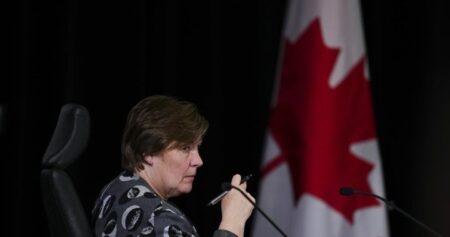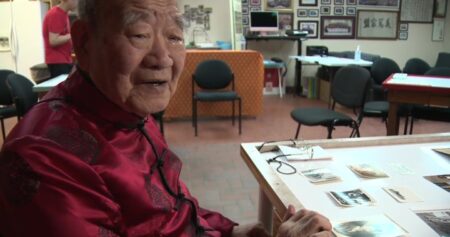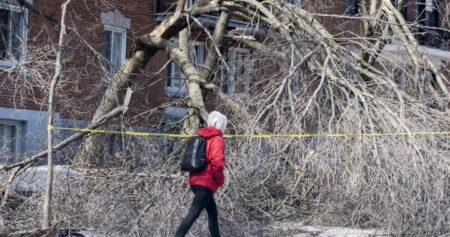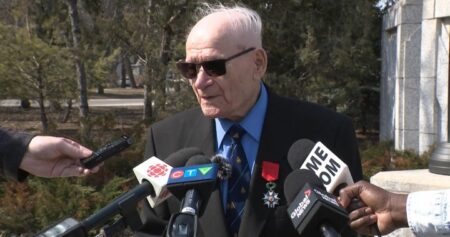The Swifties are coming, Toronto.
Six months from now, hundreds of thousands of Taylor Swift fans will be in the city to watch the music superstar perform six shows as part of her blockbuster Eras Tour.
Like many regions that have hosted Swift on this tour, Toronto will no doubt experience an economic boon, with fans spending their money on items like merchandise, food and accommodation.
The city says it’s in the early stages of event planning, which includes congestion and crowd management. However, with some of the worst traffic in the world, Toronto runs a reputational risk if it doesn’t get it under control for when Swift comes to town, one expert says.
“We have major celebrities like Tom Cruise complain about how bad our traffic is, and you can just imagine how bad it’s going to be when you have a million Canadians and foreigners coming to the Taylor Swift concerts here,” said Daniel Tsai, a business lecturer at the University of Toronto.
“The other thing (is) you don’t want her to come out and say, ‘I love Toronto, but man, the traffic is bad.’ … Bad traffic is a blight on tourism.”
Swift’s Eras Tour, which started in March 2023, has made headlines for not only the earthquakes it causes but also the seismic amount of money it brings in.
According to a July 2023 U.S. Federal Reserve report, Swift’s three shows in Philadelphia last May were a driving factor in why it was the strongest month for hotel revenue in that city since the onset of the COVID-19 pandemic in 2020.
Also in July, Swift performed two shows in Colorado, which translated into a US$140-million boost to the state’s GDP for the year, according to a report from the Common Sense Institute – a U.S. think tank that promotes Colorado’s economy.
Pat Tobin, general manager of economic development and culture at the City of Toronto, said that based on conversations they’ve had with other cities, the majority of November’s concert-goers will be tourists.
Rogers Centre, where Swift will perform, has a capacity of 40,000 people for baseball games. It can fit more for concerts, but Global News Toronto was unable to find exact figures for Swift’s sold-out shows.
In ticket sales alone, that could be at least $120 million generated, Tobin said.
Those purchases aside, Swifties will also be spending on items like food, drink and accommodation. There will also be attractions for those who were unable to get a ticket, such as the recently announced “Taylgate” fan experience.
All that tourist activity could result in an additional $500 to $600 million for the local economy, Tobin said.
“It’s worth noting the time at which they come is a bit of a shoulder season for the local tourism, hospitality and hotel sector.… The timing of these six concerts is absolutely ideal,” he said.
Breaking news from Canada and around the world
sent to your email, as it happens.
“The profile that Toronto will receive from this event, carrying through to the World Cup hosting in 2026, will only continue to drive how attractive a destination Toronto is for tourists from around the world.”
And Toronto won’t be the only region that benefits from Swift, Tsai said.
“People don’t want to just be there for the concert. They probably want to go up to Niagara Falls. They may even want to go to Montreal because that’s almost like a different society there,” he said.
“You’re going to have people not just from Canada – there’s a lot of people that couldn’t get tickets in the U.S., Europe or Asia, and they’re coming here because this is a huge event for them.”
Given Swift’s shows are six months out, the city said it’s in the infancy of event planning.
“Those discussions are ongoing, and plans will be formalized closer to the event dates,” Jaclyn Cossarini, a communications co-ordinator with the City of Toronto, said in an email.
“The city will leverage its existing event traffic management plans for the Rogers Centre and Scotiabank Arena area, which help to ensure safe and orderly movement around major events at those venues.”
Toronto, which has become notorious for its congestion, is undergoing several rehabilitation projects, including on the Gardiner Expressway.
Parts of the city’s main east-west expressway have been reduced by one lane in each direction for “critical rehabilitation work.”
Those closures will be in place for the next three years, and will only lift temporarily in 2026 for another major economic event – the FIFA World Cup.
Tsai said the city’s congestion plan for Swift’s shows must go beyond the Rogers Centre area.
Laura McQuillan, a senior communications advisor with the city, said in a follow-up statement that the city will “utilize a variety of traffic management strategies” to mitigate congestion across Toronto, including on the TTC and Metrolinx networks.
Tsai also called for the Gardiner closures to be lifted while Swift is in town, given the potential economic impact that event will also have.
“It’s making sure that you go after all the bottlenecks, including the Gardiner, because you have one bottleneck there,” he said.
“If you’re waiting two hours to get to the Rogers Centre (and) you missed the concert, that’s just amateur hour.”
McQuillan said that won’t be possible.
“Temporarily lifting the construction closures for the Taylor Swift shows in November is not feasible because the closed lanes are being demolished and rebuilt,” she said in an email, adding the reopening for the World Cup was planned well in advance.
“It is a highly technical and complex process that involves completing the demolition and rehabilitation of four lanes in time for the event, allowing the full Gardiner Expressway to be used during that period.… Other than this exception for FIFA, the restricted lane use will remain in place until the project is completed in 2027.”
At the end of the day, Toronto will rely on its history of hosting major events like the Caribbean Carnival and Pride when planning for Swift, Tobin said.
“We attract, through those events and other amenities, 25 million visitors annually,” he said.
“We’re good at this.”
Congestion aside, Tsai said businesses in the hospitality and tourism sector need to “staff up” to meet the demand.
“You end up paying a lot of overtime as well, but this is actually good for the economy because … they can spend that back into the local economy,” he said.
“Also supply chain: they have to make sure they have enough product. You’re not going to make money if you run out of food if you’re a restaurant.”
Tsai added it’s important for the Rogers Centre to open up its retractable roof during Swift’s shows.
“The sound is going to travel all the way to Liberty Village and further parts. It’s incumbent on Rogers to open up the dome and really make this a communal experience,” he said.
“This is really about having all of Toronto share in this magnificent experience of Taylor Swift and get into the lavender haze and just be part of the love story with Taylor.”
Read the full article here











